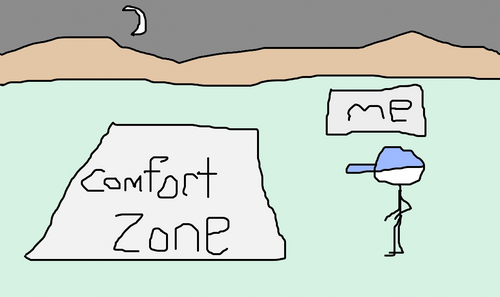Stand aside. I'm stretching out of my comfort zone here to discuss Technical Analysis (TA). I'll probably reveal my ignorance early on.

The reason I'm even trying to write about TA is because a discussion by @demotruk and @tobetada in the Hive General price and trade channel got me to thinking. When think --> write.
What's TA?
First off, it's not what you heard in the boys' locker room.
Secondly, if you're unfamiliar with TA, here's my one sentence definition:
Technical Analysis is a method of objectively analyzing market charts, data, and order books in hopes of projecting price trends.
Third, if you're familiar with TA, you're probably saying to yourself:
Yep, he revealed his ignorance early on.
I'm a skeptic
Let's get it out there up front...I'm skeptical. My gut tells me that no one can figure out markets. People are too fickle, markets do what markets do. Much of the time, it seems to me, the market and prices do exactly counter what makes sense. Every time I've started to think I've gotten something figured out in the market, I've been humbled.
No doubt, there are people who are better than others. However, I chalk up their successes to discipline. They likely have a plan, a rational non-get-rich-quick plan, and are disciplined enough to stubbornly stick to it.
Disclaimer done, I still...
Respect TA
I still have a respect for TA. There was actually a time when I was intrigued, spent a small, iota of a bit of effort trying to learn, then reverted back to my skepticism.
The reason I still respect TA is that it attempts to do what seems to me the near-impossible: to objectively weed through the nonsense.
Side story (I'll circle back to TA, promise):
When I was in school, teachers talked about "Quantitative Research" and "Qualitative Research." The quantitative was scientific experiments and correlations which yield hard-to-dispute numbers. The qualitative was case studies, naturalistic observations, interviews, and open-ended surveys. It was asking somebody their ideas, or observing for yourself and jotting notes, then sitting back and saying, "Hmm, what does this mean?" To me, the subjectivity in this was vomit on paper. What I conclude is very possibly entirely different from that person over there's conclusion. And, who's to say who's right?
Naturally, I skewed toward the quantitative. However, when mandated to do one qualitative project, I held my nose and chose to do a Grounded Theory (GT) study.
GT is qualitative trying to be quantitative. It was like a little boy trying to be like his father, I liked that. Here's the way GT works: you gather up a ton of data. Those data are usually transcribed verbal interviews, or actual writings -- it's something other people have said or written.
Then, you analyze it. (Sounds pretty subjective, I know.) But, there's somewhat of a standardized, systematic pattern to the analysis. First in your analysis, you create major categories or "codes." You just establish big "buckets", so to speak, with labels on them for each of the topics the people are talking about. Then, you create sub-categories within each code/bucket. When you've exhausted any and all codes or sub-codes, you start drawing code-bubbles and linking things on a huge flow chart diagram. Whenever your data for Sub-code A makes mention of something in your Code C bucket, you draw a line linking those bubbles. A spider web results with bubbles as hubs.
Sounds like nodes in a decentralized blockchain! 😀
This technique sounds like a mess, it kind of is, but it's interesting in that patterns begin to emerge. Similar to a word cloud that reflects word frequency in a text, things begin to literally appear visually. These are the important things. And, their linkages appear. Any linchpin emerges also. Often, things rise to the surface that we'd previously not seen in the pile of data alone. From there, we can perhaps suckle out some inferences...learn stuff.
The point with GR is that we went from a heap of information with little or no order, a mess, applied a somewhat-objective procedure, and then emerged with a somewhat-objective conclusion. It's not perfect, but it's better than nothing.
This is why I respect TA. "The market" is a whirling mess of millions or billions of people, their whims, befuddled up in a blizzard of money. That's a difficult thing to make sense of. Technical Analysis tries. Like Grounded Theory, it's not perfect, but I respect the effort.
The question
The question in the title asks if TA applies to smaller markets, like cryptocurrencies. It seems to me that smaller markets would be very much less predictable than, say, a Tesla on the NASDAQ stock market. Smaller markets are much, much more volatile when a big player, a whale, gets involved. In my thinking, even the best and most accurate of Technical Analysis would be thrown awry if a whale suddenly bought up half the order book. Or, the other way, if that whale suddenly unloaded a large volume.
To answer my own question...
Yes, TA does apply to smaller markets, because it can still be used with them. The attempt to move from subjective-to-objective persists and the tools are the same. A lumberjack chops a sapling with the same axe that he chops a sequoia. However, it must be understood that smaller markets have a much higher chance of a large, very large, market swing.

You ask, "What's Hive?" Watch the animation I made: The Hive Story Animation and you'll learn about this Web3 chain. The top benefits of the Hive blockchain: (1) no ONE person/group runs it, (2) YOU own and control your content, and (3) YOU earn the rewards that your content generates. Learn more or consider using my referral link to get your free account here and I'll support you as you begin. Alternately, you can see other sign-up options here. All my links: https://linktr.ee/crrdlx.
Posted Using LeoFinance Alpha

